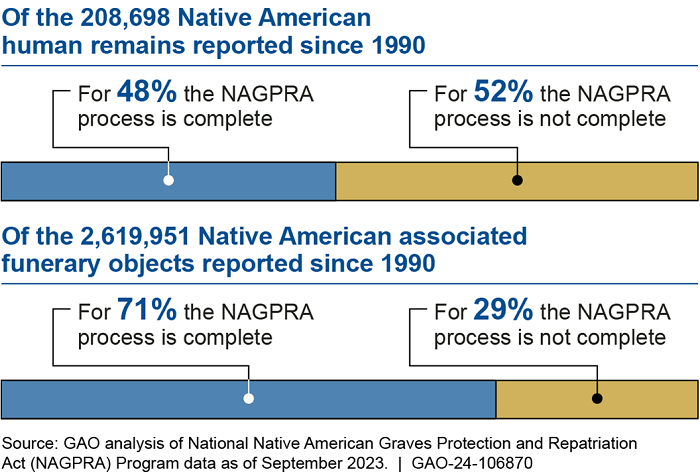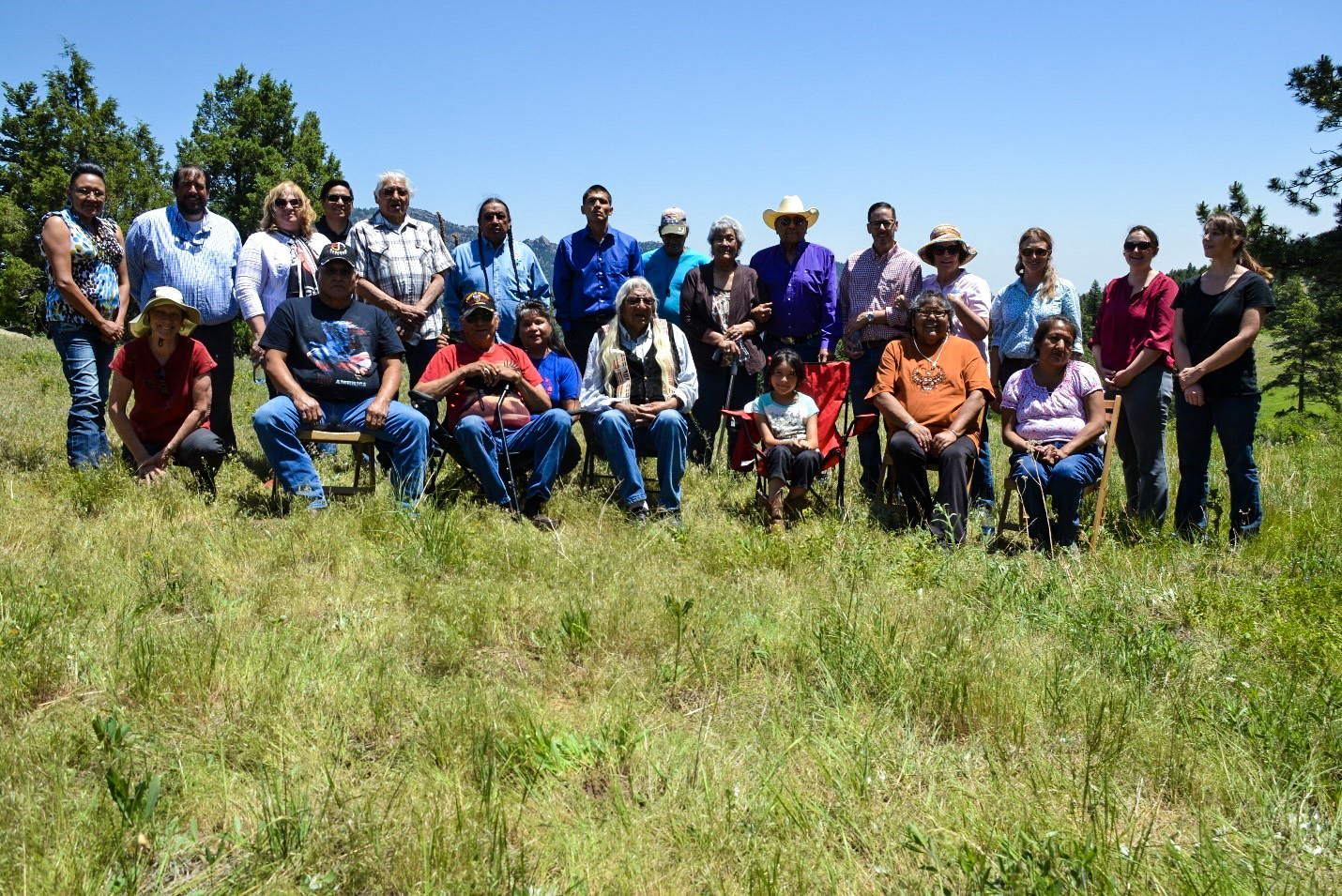Supported by a federal NAGPRA grant, tribal nations, History Colorado, Colorado State University, Colorado Department of Natural Resources and the Colorado Commission of Indian Affairs participated in a reburial ceremony in Colorado in June 2016. Photo courtesy History Colorado
Tuesday, October 10, 2023
By Acee Agoyo
Indianz.Com
It’s been more than 30 years since the passage of the Native American Graves Protection and Repatriation Act
(NAGPRA) but federal agencies and museums are still far behind in
returning ancestral remains and cultural property to their rightful
places.
A snapshot report released by the Government Accountability Office
(GAO) on Tuesday shows just how NAGPRA’s promises to Native peoples
are going unfulfilled. Since 1990, fewer than half of the 208,698
ancestral remains being held by agencies and museums have gone through
the complete NAGPRA process, according to official data.
And when it comes to the 2,619,951 sacred items being held by agencies
and museums, the record is better — but the GAO identifies ongoing
“challenges” in complying with NAGPRA. According to the report, issued a
day after President Joe Biden declared Indigenous Peoples’ Day, nearly
a third of funerary objects haven’t gone through the complete process.
“The program’s 2022 report notes that these agencies and museums have
not completed the NAGPRA regulatory process for 52 percent of human
remains and 29 percent of associated funerary objects,” the GAO report
states.
“Until the process is complete, the items are not available for
repatriation,” the report adds, confirming that American Indians, Alaska
Natives and Native Hawaiians are still being denied their ancestral and
cultural heritages, some 33 years after NAGPRA’s passage in 1990.
To help improve compliance with NAGPRA, GAO recommends federal agencies
strengthen their tribal consultation policies. The report refers to
“concerns” raised by lineal descendants, tribes and Native Hawaiian
organizations.
“Failure to consult with tribes, or to consult effectively, may result
in irrevocable damage to cultural resources,” the GAO states.
The report also states that the U.S. government isn’t doing enough to
address the illegal removal of cultural items from federal and tribal
lands. According to the GAO, “resource constraints, competing
priorities, and limitations with data to support decision-making have
hampered agencies’ efforts to prevent, investigate, and prosecute
incidents of theft and damage.”
Congress has taken additional action to protect tribes with the passage of the Safeguard Tribal Objects of Patrimony Act, also known as the STOP Act. The GAO report notes that the Department of the Interior has started developing regulations to implement the new law, an effort that began just a few months ago.
The GAO also points out that Interior has yet to finalize new NAGPRA regulations
that are supposed to streamline the repatriation of items held by
federal agencies and museums. The work began more than two years ago, in
the fall of 2021, and the proposed revisions were released almost a year ago.

According to the Government Accountability Office, federal agencies and
museums have not completed the NAGPRA regulatory process for 52 percent
of human remains and 29 percent of associated funerary objects as of
September 2023. Source: Native American Priorities: Protection and Repatriation of Human Remains and Other Cultural Items
Finally, the GAO said the sale of tribal items in overseas markets remains an ongoing challenge. Implementing outstanding recommendations from prior NAGPRA reports in 2010, 2018, 2019 and 2021 could help address the issue, according to the report. “Implementing the remaining eight could help Interior target efforts to analyze and address risks to Native American cultural resources and improve how federal agencies communicate with tribes that request assistance with repatriating cultural items from overseas auctions,” the GAO said, noting that 47 other NAGPRA recommendations have been “fully implemented” as of September 2023. “This could also improve agencies’ efforts to consult with tribes on certain federal efforts that could affect cultural resources,” the report continued. The 2010, 2018, 2019 and 2021 NAGPRA reports were followed by Congressional testimony in February 2022, when the GAO discussed the challenges facing federal agency compliance with the law.

Finally, the GAO said the sale of tribal items in overseas markets remains an ongoing challenge. Implementing outstanding recommendations from prior NAGPRA reports in 2010, 2018, 2019 and 2021 could help address the issue, according to the report. “Implementing the remaining eight could help Interior target efforts to analyze and address risks to Native American cultural resources and improve how federal agencies communicate with tribes that request assistance with repatriating cultural items from overseas auctions,” the GAO said, noting that 47 other NAGPRA recommendations have been “fully implemented” as of September 2023. “This could also improve agencies’ efforts to consult with tribes on certain federal efforts that could affect cultural resources,” the report continued. The 2010, 2018, 2019 and 2021 NAGPRA reports were followed by Congressional testimony in February 2022, when the GAO discussed the challenges facing federal agency compliance with the law.
The leader of the Senate Committee on Indian Affairs said it was clear that the work was far from complete.
“While progress is certainly being made, the journey continues for tens of thousands of ancestors
and millions of cultural items to find their way home,” said Sen. Brian Schatz
(D-Hawaii), the chair of the legislative committee, noting that
Congress originally thought it would take 10 years to repatriate
ancestors and items held by agencies and museums.
“And the promise of NAGPRA continues,” said Schatz.
Indianz.Com Video: ‘Our iwi, our bones are sacred’: Nāpua Greig #NAGPRA
Sen. Lisa Murkowski
(R-Alaska) said NAGPRA has helped Native people in her home state of
Alaska reclaim 1,843 ancestors from museums and agencies. “But there is
much more to be done,” she added.
“The work is not finished,” said Murkowski, the vice chair of the
committee. “There are still 406 Alaska Native individuals who remain
housed in 26 museums or federal agencies, pending consultation and
notification prior to repatriation.”
At the hearing, experts on repatriation in Native communities explained why compliance with NAGPRA is so important to them. Carmen Hulu Lindsey, the chair of the board of trustees for the Office of Hawaiian Affairs, said it is critical for the iwi, or the bones, of ancestors to return home.
“We identify with each other, literally, by the bone,” Lindsey told the committee, which opened the hearing with a Native Hawaiian song about the important cultural tradition. “Not only do the iwi
possess the spiritual power and essence of the individual, they are
also our direct connection to our ancestors for communication and
guidance.”
“For we do not bury our dead, we kanu, or plant them, back
into the earth from whence they came to continue to nourish, heal and
guide future generations,” she continued. “This critical cycle has been
disrupted due to the mass disinterment and disaggregation of our
ancestors, especially in the last century of unfettered development in
our island home.”
Rosita Worl, the president of the Sealaska Heritage Institute in Alaska, served on the NAGPRA Review Committee for 13 years, monitoring and reviewing the implementation of the law. She
said Native people face a second indignity even when their ancestral remains are returned to their communities.
“I would also recommend and allow for the reburial of ancestral human remains at the site from which they were taken,” said Worl, a citizen of the Central Council of Tlingit and Haida Indian Tribes.
“Often, we are told to sneak onto federal lands, to rebury our
ancestors from the original site from which they were taken. We do not
believe that this is appropriate.”
The GAO’s snapshot report was based in part on data released by the
Department of the Interior’s National NAGPRA Program. The figures about
completed reviews of ancestral remains and funerary objects are taken
from the annual program reports.
The 2022 report,
for example, shows that 108,328 ancestral remains are still being
held in collections across the country.
According to the data, Illinois, Ohio and California are home to museums and agencies with the largest numbers of Native ancestors. A table in the report further shows that the University of California at Berkeley, the Illinois State Museum and the Ohio History Connection are holding onto the three largest collections of Native ancestors. Harvard University in Massachusetts closely follows.









No comments:
Post a Comment
tell us your thoughts!